

When I was a kid, I used to watch Star Trek with eyes and mind wide open. What an incredible view into the future that show gave. And it was all positive. Sure, there were problems to solve, but it was essentially an extremely positive vision of the future of mankind. In Gene Roddenberry’s Star Trek vision of the future, we had stopped focusing on money and the constant acquisition of wealth and material possessions, and instead focused on developing ourselves and our knowledge and our skills. Everyone contributed according to their gifts, and in doing so, made their gifts stronger, and their contributions to society greater.
Of course, one of the fun aspects of any sci-fi story is the gee-whiz gadgets and technology of the future. That original series aired from 1967 to 1969, and in those days, anything past the year 2000 was a whole new century away and far in the distant future. Well, here we are in the future, right now. It’s not yet the 2160 era of the original Star Trek, but it is 2006. This might be a good point to check to see how far we have come in our technologies.
I have been reading various articles in various science magazines recently and I came across several announcements of discoveries and inventions that seemed like something I had seen on Star Trek when I was young, so I thought I would just take a look around and see what other Star Trek technologies might be here already - or might be relatively close. Are we anywhere close to the original Star Trek world? If so – in what areas?
As it turns out, some of the technologies have been shown by physicists to be impossible to achieve with any amount of technological development because they defy the laws of physics themselves, or because the demands for power or fuel are simply impractical. Warp speed for faster than light travel, for instance. However, we HAVE already caught up to the amazing technologies from that potential future in some areas, and we are making progress in others, and in a few, we have even surpassed the Star Trek future already.

Antigravity
In the Star Trek world, they had the ability to have objects hover noiselessly without big fans or tiny rocket engines giving thrust. They just floated silently and effortlessly in the air, and so heavy objects could be lifted electronically and easily guided or maneuvered to wherever they needed to be. Shuttle craft could easily lift off from a planet surface this way as well, before engaging the thruster drive that propels them out to space.
We actually have that technology in a very limited capacity today. We now have something called, “Lifters” which are based upon a scientific principal known as the “Biefeld-Brown Effect”. Lifter technology is a method of producing directional thrust using an electromagnetic propulsion system that has no moving parts. Although, this works by producing a field-effect thrust, rather than actually canceling the effects of gravity, still, this could be considered the effective equivalent of antigravity. The people at American Antigravity are currently conducting experiments with electrokinetic propulsion, and are in the process of developing a practical source of electrokinetic propulsion for possible use as a vehicular propulsion source.
Their experiments are conducted using modified Biefeld-Brown effect transducers, which convert high-voltage electrical current into motive force. Their experiments are currently to the point of being able to levitate a tethered Lifter for an indefinite period of time while carrying payloads of up to 1 pound. While this is a very small payload at the moment, it demonstrates a propulsive efficiency orders of magnitude higher than alternative electrokinetic technologies.
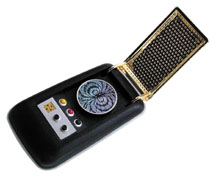
The Communicator
In the original ST, they had a small, wireless handheld device that flipped open and allowed a person to talk to the ship or each other from a distance. It also allowed someone else to find their position anywhere on the planet. Who can forget the now-classic gesture of William Shatner flipping open his communicator, squinting his eyes and speaking into it, "Kirk to Enterprise. Scotty. Beam me up."
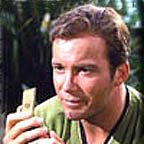
We do certainly have this type of communicator today. Many modern cell phones are flip-open style, and as of last year, all models are now being manufactured with a GPS chip installed so our whereabouts can be determined by emergency services such as police or fire rescue teams looking for a person stranded in the wilderness, or wherever. In fact, we have surpassed this particular tech vision with all the other features added into phones these days such as email, text messaging, color displays, even full access to the web, weather services, etc.
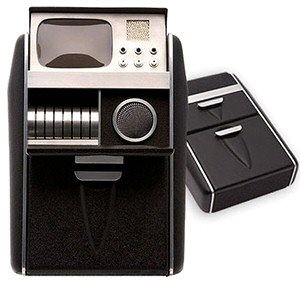
Tricorder
This was another handheld device about the size of a hardcover book with a tiny little video screen on the top. It was a multi-purpose device that had several different kinds of detectors in it. It could record audio and video and display it. It could detect lifeforms in the immediate vicinity (The police have handheld infrared heat detectors that can do this now - even through the walls of a house) It could analyze samples of biological material and innate material to tell the components.
These days we have a host of handheld technology. Consider the notebook PC. It is ubiquitous and it is very powerful. Many now have built-in cameras and microphones, of course, so audio and video recording are simple. Also, they have an enormous encyclopedia of knowledge on board if you choose to load the software, and they have wireless access to the entire world’s knowledge through the internet. Also, they have a 15” color screen at a very high resolution. Also, you can have a built-in GPS sensor, and mapping software to tell you exactly where you are on the planet at any given moment and even allow you to plot an exact travel route to wherever you need to go. Plus, you have word processing, spreadsheet, and database capabilities. In all these ways, they actually surpass the ST Tricorder. As for sensors, well, we have a number of items, such as the Police's infrared viewers to see people inside their homes, and we have various handheld spectrographic analyzers that can be considered senors of a sort, but I think we still have a ways to go there, before we catch up with the full version of ST's tricorder all in one package.
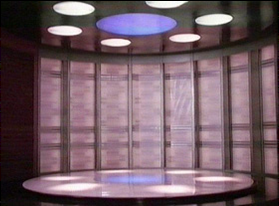
Transporter
In Star Trek, they had a device called a transporter, which converted any object, including humans, into an energy pattern, then sent that energy to another place and remotely re-assembled the pattern into the original shape. So a person would stand on the transporter platform on the ship in orbit around a planet, and then is ‘beamed” down to the planet surface. According to the ST tech descriptions, there is a distance limit of about 20,000 miles for this. Imagine traveling anywhere around the Earth instantaneously – no airports, no long waits, or long boring flights. You just beam yourself to Venice for a vacation.
In 1966, this was a novel and fascinating idea, but it was pure fantasy. It was originally created simply as a plot device to save money since they couldn't afford to create film clips of the Enterprise landing on different planets every week. But it turned out to be a wonderful idea that captured the imagination of virtually everyone in the world at one point or another.
Now, only 40 years later, modern science has already succeeded at another, but related, form of teleportation – this one produces a physical change in one place from another location without any physical connection existing between the two. Researchers at the California Institute of Technology, Aarhus University in Denmark and the University of Wales have all claimed to have achieved real teleportation. What they transported wasn't any person or object - it was the quantum property of a photon or light particle. To accomplish this, they use an unusual feature of quantum mechanics - the set of physics rules that take over from normal, Newtonian laws of physics at the sub-atomic levels.
This particular feature is called quantum entanglement and it happens when you create two particle twins from a single sub-atomic particle. The quantum properties of such particles will always be opposite, no matter how far apart they get. If you change one, you instantly change the other - even if the particles are at opposite sides of the universe. And the change will be instantaneous. Albert Einstein referred to this as "spooky action at a distance." This paradox has existed on paper for more than 50 years. But it wasn't until more recently that researchers were able to prove this process actually works, that it's been happening in nature since the dawn of time and that it could be exploited by humans to achieve bona fide teleportation.
Essentially, the scientists took advantage of quantum entanglement to produce two special, 'entangled' beams of light, one the mirror image of the other. By measuring (and thereby changing) the quantum state of one of these light beams, they managed to measure a change in the quantum state of the other. Caltech's experiment went a step further: there, researchers combined an input beam with one-half of two entangled beams, sent information about the new, combined light along a non-quantum, classical communications channel to a receiver. The receiver then combined that signal with the second entangled beam, recreating the original input beam!
The logical extension then, is that if you take an object made up of atoms, and then create quantum paired atoms – twin atoms – then communicate those to the new location electronically, then you will have transported the object.
This is highly speculative, and requires a tremendous evolution of science and technology to get the rest of the way – but at least there is a direction, and an interesting anomaly of science upon which to hang some hope.
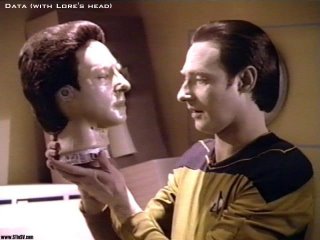
Computers
Who could forget the decidedly female voice of the ST computer on the Enterprise? (by the way, the computer voice was actually performed by Majel Barrett - Gene Roddenberry’s wife. She played Number One in the original Pilot, and then later played Deanna Troi’s mother in the Next Generation series. She was the only character that actually managed to play in all the ST series and movies in some form) Besides being a computer that you could talk to and one that could talk back, it could also store tremendous amounts of information. But in fact, as impressive as the Enterprise ship computer was, the most advanced computer of the ST timeframe was probably the brain of Data, the android. That was said to hold approximately 88 Petabytes, and to process at a speed of 60 TFLOPS.
In the current real world, the largest non-military database in the world is 480 terabytes and the current fastest computer in the world is the Blue Gene/L with a computational speed of 280 TFLOPS. So we are not yet at the storage capacity stated by ST, but we have already surpassed the computational speed.
Also, ST introduced the idea of small square plastic cards containing information that were portable and could be plugged into the computer. In the real world, we now have had diskettes that looked almost exactly like the ST ones, and then CDs and DVD’s and now even Blue Laser DVD’s that can store over 100 gb of data on a single disk. So we have surpassed ST there as well.
Also, ST showed flat panel displays, which we now have in abundance. Virtually all computers now come with flat panel LCD displays. Certainly all notebooks do. ST also had touchpad screens – these have also been in use now for many years. Many common ATMs have this technology.
Star Trek also showed small, handheld computers. We now have this in PDA’s And these have full-color screen and touch-sensitive data entry screens in them. And, like cell phones, they can connect to the internet through a blue tooth wireless net connection.
For computers that speak, we have had cars for many years that have digitally encoded voices that speak a set of messages, and we have also had programs that will interpret any typed words into speech on the fly. So we’ve got that direction covered. We even have interactive voice-operated systems used in telephone systems that ask questions and interpret your answers and capture the info you speak into data which is sent to an analyst’s workstation to begin your claim. This interactive voice recognition and interpretation is actually quite similar to the ship's computer on ST.
As for dictating to the computer, there are a number of products that do this now. This helps a lot of people who are blind or have other disabilities. Strangely, it hasn't really taken off as the primary method of interacting with computers for most people. This may be because of the error factor. (You often have to repeat the message before the computer understands you), or because of the fact that you need to build a vocabulary of words in your speech patterns/accent. Also, there is the noise factor. Can you imagine the floor of a busy office where a hundred people are all TALKING to their computers instead of typing? What a cacophany of noise! I always wondered how the computer on ST knew when to pay attention to Captain Kirk in a busy hallway, and not pay attention to the crewmembers walking by talking about something different...
Also, on ST, there was an experiment with a new computer called the M5. This computer was meant to replace the crew of the Starships and run the ships automatically. Current on-board computers on the latest Airbuses and Boeing passenger air could eliminate the flight crew but the human factor prevents the airlines from doing so. But the technology is certainly there already today.
Also, the military is building remote-control jet fighters, with no pilots. This is already being done with several models today. It allows much smaller, much faster aircraft that can be made to perform incredible aerobatic stunts because there is no human on board to have to be gentle for. However – it also reduces air battle to high-stakes video-game status. This technology exists, but is not yet commonplace.
Medical Technology
In the ST future, there were a number of very useful technological tools to help doctors help people. There was the medical scanner bed that scanned a body and showed a number of readings on an overhead display. Then there was the medical tricorder that could scan portably and show similar info. Then there was the hypospray, which did not insert a needle through the skin, but instead sprayed the medicine onto the skin in a controlled way that allowed it to seep through the skin into the bloodstream. Also, doctors of that period had tools to regenerate tissue growth.
Today, we already have some of these very same technologies. CT scanners and MRI scanners are current-day technology where there is a bed the patient lies upon, and there is a scanning machine which has various ways for looking for illnesses and problems and can give 3-D views of a human body without dissecting it. Also, there are small hand-scanners, very much like the medical tricorders of ST.

We also now have hypospray delivery systems, which work exactly like the ST versions. They accelerate the medicine and spray it onto a small patch of skin and the medicine penetrates the skin and enters the blood stream that way.
In the cover story of this month’s Popular Science magazine there is even an article showing a new technology currently being developed which will help people re-grow tissues and even organs that have been damaged. The biological agents are delivered through a spray gun – and can even be self-administered. This is a truly mind-boggling advancement in medical science, and it’s currently being developed by Hydra Biosciences in Boston with help from Harvard medical researchers.
The way it works is that the gun sprays regenerative protein molecules into the bloodstream. The molecules bind to receptors on the surfaces of a damaged organ such as the heart, and this touches off a chemical reaction that mutes specific genes that inhibit cell division to allow the growth to occur – “naturally”. This is because the organ is secreting the chemical regrowth hormones all the time anyway, but the messages are being ignored or deflected by these genes. Stopping that deflection allows the growth – the tissue repair – to occur. Once the organ is repaired, stop the treatment, and the genes take over again, and the repair tissue regeneration stops again. This is not yet on the market, but they have been working on this for four years and apparently they are getting close.
This was the article, in fact, that gave me the idea to write this piece. When I read it, I thought to myself, “This is amazing! – it’s like something right out of Star Trek!” Then I started thinking about other technologies from Star Trek that are here already or almost here.
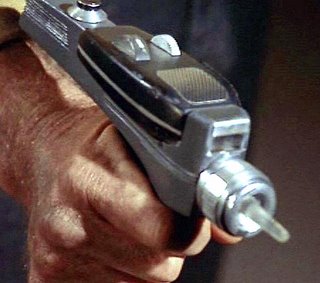
Phasers
The weapons of ST were, of course, spectacular. But everyone certainly remembers the “Phaser” This is a handheld, pistol-shaped energy weapon that delivers a laser-like beam that superheats and melts the target object.
Of course, we have had laser weapons for many years. Currently, there is even a military pickup truck built by GM that has a laser cannon that pops-up through the roof and fires a powerful laser beam that can destroy a tank. I saw a demonstration of this on a PBS documentary a couple of weeks ago. The device is relatively small. It could easily be handheld by a man. I believe the origin of this idea actually came from Nikola Tesla, when he invented the so-called “Death Ray” in the early 1900s.

Cloaking Device
This was an interesting technology introduced by ST as belonging to the Klingons and the Romulans – two enemy races of humankind. It was a device that could make a spaceship turn invisible. Ironically, The Federation (Humans) felt it was a technology that was somehow ‘cheating’ or was ‘cowardly’ or something and so had agreed not to develop or use it.
Well, in current real life we have started down the path of this technology now as well. – BBC, MAY 3, 2006; “Nicolae Nicorovici and Graeme Milton propose that placing certain objects close to a material called a superlens could make them appear to vanish. It would rely on an effect known as "anomalous localised resonance"”.
So far, they have managed to make it work, but with only tiny objects such as a spec of dust. But how long before this technology is expanded to include large, complex objects such as a bomb or tanks, battleships, fighter jets… or even spaceships?
This was another recent article that made me think of how close some of our technology is to the world of Star Trek.
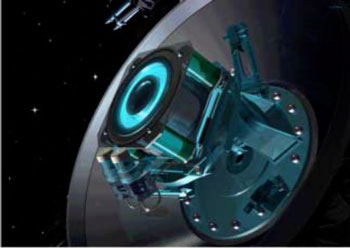
Space Drive
Besides the Antimatter-fueled, dilithium crystal-driven warp drives of the Enterprise, ST also talked about Ion Drive. This has also now come to pass. ESA’s SMART-1 moon probe, next generation called DS4G, dual-stage 4 grid using an ION drive was successfully tested by the European Space Agency and the Australian National University in Jan. 2006. The picture above is this probe and it is currently scheduled in orbit around the moon.

Antimatter
This was the source of the huge power needs of ST’s Enterprise Starship. It was long thought to be only theoretical, but later it was proven to be true. Then in 1995, it was actually accomplished. CERN, which is an advanced physics research agency in Europe announced that it had successfully created antimatter. Specifically, they created 9 atoms of anti-hydrogen.
Today, antimatter is used regularly in PET scanners that are used for brain scans. These don't use entire antimatter atoms, but instead use anti-protons.
Most nuclear fission has a relatively low conversion/annihilation rate, and so the amount of energy released in an explosion, although frighteningly powerful, is still rather low compared to antimatter. Antimatter has a 100% annihilation rate when it meets with normal matter, so the power created in its explosion is unbelievably powerful. A relatively small amount, exploded in a bomb, could destroy the entire planet Earth.
We now have the means to create this power source. But it is expensive and time-consuming and only a few atoms have been created so far. But it's important to know that any sufficient quantities represents a huge risk if put in the wrong hands.
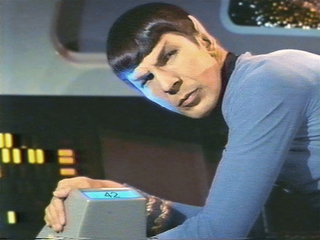
Scanning a planet for lifeforms.
As the Enterprise approached a planet, Mr. Spock would look through a visor into a display which scanned the planet and could tell which types of plants and other biological lifeforms were present, and the percentages of each.
Today, I have a friend who is a biologist for the Department of the Interior here in the US, and her job for the past several years has been to be able to perform just that type of analysis - at least for the plant life - based upon arial photography.
Is it such a large stretch to imagine the pictures are taken from space instead of from the nosecones of helicopters? If satellite images from space have the resolution to read the headlines on a newspaper held by a man on the ground, isn't that enough resolution to detect plant-life? I wonder. And then is it too much to think that the analysis could not one day be automated and programmed into graphical analysis in a computer so that it is not so labor intensive, and could be done quickly? If these two assumptions are within reason, then it is not unreasonable to assume we could have this technology before very long.

Replicator Manufacturing
In the ST world of the future, most people had interesting jobs that utilized their minds and talents rather than simply using their bodies, or forcing themselves to perform rote-repetitive work such as manufacturing on an assembly line. The assembly line had become automated (as it has to a degree now with robotics), and then the technology of Replication had been invented. With this, a 3D computer model could be translated into an actual manufactured object in a fully automated way.
This technology exists today, though it is not yet widespread. Computerized CAD/CAM (Computer Aided Design and Computer Aided Manufacturing) software such as AutoCAD is used to build a precise digital 3D model of an object to be manufactured. This, then, is sent to a fabrication machine which translates those digital coordinated in digital 3D-space into the same coordinates in real space. In one machine I saw in a documentary a few years ago, this was done using an automated form of an old carpenter’s tool called a shape tracer. It is a series of thin metal pins that are slid into position against a lathed piece of wood that serves as a table leg, let’s say. Then, then the edges of the pins form the outline of the profile of that leg, so that the carpenter can use that as a guide when cutting the other table legs to match.
This is similar to that except that it is not just a single row of pins. There is a complete array of them to cover a multi-textured complex 3D surface, and they are all automated and controlled by the computer which adjusts each pin individually. When they are set in position according to the 3D digital model in the computer, then the assembly is lowered into a vat of liquid polymer, which then coats the mould, and then the mould is lifted out, and the polymer is quick dried on the mould, and when the mould is split apart, the physical manufactured piece is dropped out onto the assembly line.
These 3D digital representations already exist for many, many objects, since people use them all the time in 3D modeling for movies, commercials, and for specifications of manufactured goods. However, even they can be automated. There are other tools that perform a multi-layered 3D scan of any object (living objects as well – it can do your face or your body for example), then this scan is fed directly into the CAD/CAM software to create a 3D digital model.
In Japan, this has been used to create custom manufactured suits for years. The customer’s body is scanned in detail, the 3D digital model is created, then the model for the clothing is made from that. The customer chooses the material, the material is cut with lasers, and the suit is manufactured on the spot exactly to fit the client in approximately an hour.
Although it may not just magically appear in the replicator chamber like it did in ST, at least the technology does exist to provide this functionally to some degree.
At this website: http://www.vnunet.com/vnunet/news/2127008/star-trek-replicator-step-closer
is an article describing how Dr. Adrian Bowyer of Bath University has constructed a machine about the size of a washing machine that can replicate common household objects of out metal and plastic. He is planning for the day that the machine can actually begin to replicate itself. At the moment, this machine is available for about 25,000 UK pounds., but he expects it to one day be available for about the cost of a modern computer printer.
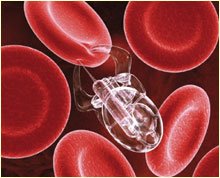
Nano-Technology
In ST Next Genration, they experimented with tiny little machines that acted according to programmed instructions. These have been created already in the fields of medicine and other research. More research is still underway to develop them further and add more and more intelligence to the tiny robots.

Human Genetic Engineering
In The ST world this was certainly possible, but had been abandoned in ST's past because it was deemed undesirable. In real world technology today, we have in fact now mapped the entire genome of a human being, so it is now becoming much more possible to start tweaking the model to eliminate congenital disease, or enhance certain attributes, like resistance to viral or bacteriological disease, longer life, staying thin, eliminate balding or eyesight problems – or even increase a person’s attractiveness.  This purportedly does not yet exist today, but it certainly will soon. Already in the US, there are several companies that will clone your pet. Can cloned humans really be that far off? And can ‘adjusted’ engineered humans be that far after that?
This purportedly does not yet exist today, but it certainly will soon. Already in the US, there are several companies that will clone your pet. Can cloned humans really be that far off? And can ‘adjusted’ engineered humans be that far after that?
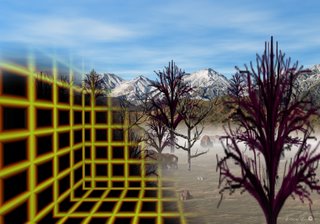
The Holodeck
Here was a wonderful invention of the fictitious future world by ST visionaries. A computer-generated illusion created in a specialized room, where any environment could be created by a computer program. Then the world can interact with the visitor in real-time. Plants that sway as you brush by them, the world keeps making you think you are walking a distance, when it is actually cleverly maneuvering you into walking around in a circle to keep you from bumping into the real holodeck walls.
It creates characters for you to interact with and even holds down interesting conversations. In the series, this device was used to allow the crew to have personal vacations climbing mountains, or exploring distant planets, or learning new things from the masters of those disciplines, etc. Any number of apparently real adventures were possible. The possibilities for sex alone are endless!
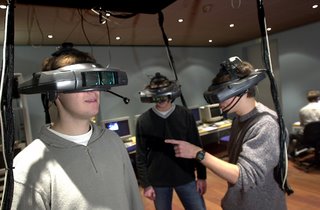
In the real world of present day, we have Virtual Reality. This started out as a very crude computer-generated world where the visitor uses gloves and a visor connected to the computer and the computer allows the player to interact within the cyberspace environment. It can tell where the player “is” at any given moment, and as they move, it translates that into movement within the space and then alters the point of view to that new space and feeds that back to the sensor equipment that the player is wearing. This gives them the illusion of actually moving around through a digital world. Over the years, this has evolved considerably in terms of resolution and quality. But it’s still not convincingly real yet. But they are on the right track.
As we seem to be with many of these technologies. Maybe Roddenberry's vision of the future of mankind was not quite so far off after all.

 This flower is just one of thousands that line the walkways and sidewalks everywhere. Flowers and flowering trees are literally everywhere. There are of course many thousands of palm trees in Hawaii, and unbelievable Monkey-Pod trees with their perfect canopies that look like they've been trimmed. And just about any tree that wasn't a coconut palm or a Monkey-Pod or a Banyan tree, was some kind of flowering tree with beautiful blossoms. There was one type of tree that showed startling orange-colored blossoms. It is the African Tulip tree. The tour guide pointed them out as we drove past. She said the flowers are beautiful but they are filled with water and the water stinks like a skunk. As children, they used to chase each other and squirt each other with the stinky water. I could just picture that.
This flower is just one of thousands that line the walkways and sidewalks everywhere. Flowers and flowering trees are literally everywhere. There are of course many thousands of palm trees in Hawaii, and unbelievable Monkey-Pod trees with their perfect canopies that look like they've been trimmed. And just about any tree that wasn't a coconut palm or a Monkey-Pod or a Banyan tree, was some kind of flowering tree with beautiful blossoms. There was one type of tree that showed startling orange-colored blossoms. It is the African Tulip tree. The tour guide pointed them out as we drove past. She said the flowers are beautiful but they are filled with water and the water stinks like a skunk. As children, they used to chase each other and squirt each other with the stinky water. I could just picture that. Just take a look at this awesome Banyan tree. This is on the front lawn of the Honolulu Zoo which is also right at Waikiki and within a 15 minute walk of our hotel. Unfortunately, it was closed on the day we went there.
Just take a look at this awesome Banyan tree. This is on the front lawn of the Honolulu Zoo which is also right at Waikiki and within a 15 minute walk of our hotel. Unfortunately, it was closed on the day we went there. I actually climbed to the very top of the mountain(actually, it's a volcano) you see here. This is diamondhead, and at the very top is a tiny little observation station. I climbed to that point (which was a bit of exercise, I can tell you!) and then took pictures all around including back down toward the city. You are looking at Honolulu, and right in the middle is Waikiki Beach including the place from which I took the above picture. So both pictures include the place each other was taken from.
I actually climbed to the very top of the mountain(actually, it's a volcano) you see here. This is diamondhead, and at the very top is a tiny little observation station. I climbed to that point (which was a bit of exercise, I can tell you!) and then took pictures all around including back down toward the city. You are looking at Honolulu, and right in the middle is Waikiki Beach including the place from which I took the above picture. So both pictures include the place each other was taken from. Honolulu is, of course a large city - 10th largest in the US, and it has it's expected share of slums and dirt, etc.but even the older buildings with peeling paint and cracks in the walls just look charming in a setting as beautiful as Hawaii.
Honolulu is, of course a large city - 10th largest in the US, and it has it's expected share of slums and dirt, etc.but even the older buildings with peeling paint and cracks in the walls just look charming in a setting as beautiful as Hawaii. The mountains and beaches and the shining crystal seas. The warm temperatures, but cooling breezes - all conspired to make me fall in love with the place. We stayed at the Sheraton Princess Kaiulani Hotel, right at Waikiki Beach, and yet it wasn't as expensive as I would have thought.
The mountains and beaches and the shining crystal seas. The warm temperatures, but cooling breezes - all conspired to make me fall in love with the place. We stayed at the Sheraton Princess Kaiulani Hotel, right at Waikiki Beach, and yet it wasn't as expensive as I would have thought.  About $155 per night. That's less than a hotel room in San Francisco. This is a picture of it. It's a bit dated, and the rooms are not the most lavish I've seen. It's probably only a small notch above a Holiday Inn - but the location cannot be beat. It is in the prime spot right on Waikiki Beach road, right at the edge of all the shopping and the open beach. It was perfect for walking around and seeing everything. ABC stores are everywhere and cheap. They have most of the essentials you might need. Like a 7-11 store but also sells hats and t-shirts and towels, etc. More than a convenience store. Meals in the area were not outrageously expensive - Perry's has a buffet all day long for only $6.95 per person. And the International Marketplace is right beside the hotel and has all the tourist junk you could ever want, from 8 t-shirts for $20, to strings of pearls for $15.
About $155 per night. That's less than a hotel room in San Francisco. This is a picture of it. It's a bit dated, and the rooms are not the most lavish I've seen. It's probably only a small notch above a Holiday Inn - but the location cannot be beat. It is in the prime spot right on Waikiki Beach road, right at the edge of all the shopping and the open beach. It was perfect for walking around and seeing everything. ABC stores are everywhere and cheap. They have most of the essentials you might need. Like a 7-11 store but also sells hats and t-shirts and towels, etc. More than a convenience store. Meals in the area were not outrageously expensive - Perry's has a buffet all day long for only $6.95 per person. And the International Marketplace is right beside the hotel and has all the tourist junk you could ever want, from 8 t-shirts for $20, to strings of pearls for $15.

 visiting the sunken USS Arizona, visiting the USS Bowfin Submarine, snorkelling, a large luau, and going to see a real Hawaiian Chief and his men in full traditional Hawaiian dress, giving lessons on how to open coconuts, showing us how to get coconut meat out of the coconut, how to start fire with two sticks of wood, and also cracking jokes all along. In fact, I'd say his little show there is primarily a comedy act. When he started fire by rubbing one stick against another log, I asked asked him what kind of wood he was using. He looked at me and in a straight face said, "firewood". He had terrific - perfect - comedic timing. Then there was swimming in the ocean at Weimea beach - the international surfing capitol, and catamaran rides, etc. And of course, shopping. Lots of activities to keep us busy for 8 days.
visiting the sunken USS Arizona, visiting the USS Bowfin Submarine, snorkelling, a large luau, and going to see a real Hawaiian Chief and his men in full traditional Hawaiian dress, giving lessons on how to open coconuts, showing us how to get coconut meat out of the coconut, how to start fire with two sticks of wood, and also cracking jokes all along. In fact, I'd say his little show there is primarily a comedy act. When he started fire by rubbing one stick against another log, I asked asked him what kind of wood he was using. He looked at me and in a straight face said, "firewood". He had terrific - perfect - comedic timing. Then there was swimming in the ocean at Weimea beach - the international surfing capitol, and catamaran rides, etc. And of course, shopping. Lots of activities to keep us busy for 8 days.
 Here is a picture of Jonelle explaining about the beach sand and where it came from. As she explained, the sandy beach of Waikiki is not native to Hawaii. Originally that was all swampland. This sand was all imported from Australia. This picture was taken when we visited a small island that used to be used for filming "Fantasy Island" TV series years ago Starring Ricardo Montalban.
Here is a picture of Jonelle explaining about the beach sand and where it came from. As she explained, the sandy beach of Waikiki is not native to Hawaii. Originally that was all swampland. This sand was all imported from Australia. This picture was taken when we visited a small island that used to be used for filming "Fantasy Island" TV series years ago Starring Ricardo Montalban. They talk about Koa wood with reverence. It is very rare now on the islands, and the few pieces that are made from it are VERY expensive - usually displayed behind glass. (as you can see with this small jewelry box). I told her that I have named all my guitars, and that I named my Koa bass and guitar, "Thunder" and "Lightning" respectively. Her mouth fell open and she explained that this was a very spiritual thing. In the earliest times of her people, the thunder and lightning were the music of the Gods. For me to have guitars made of solid Koa wood, and to have named them Thunder and Lightning was too much of a coincidence, and she and I both got goosebumps. She gave me the Hawaiian names for Thunder and Lightning as Kau ila. for Thunder and Hekili for Lightning. Below is a picture of my guitar and bass. The color is actually the same on both, but this picture was put together from two other pictures and the lighting was different, so it makes the color look different here.
They talk about Koa wood with reverence. It is very rare now on the islands, and the few pieces that are made from it are VERY expensive - usually displayed behind glass. (as you can see with this small jewelry box). I told her that I have named all my guitars, and that I named my Koa bass and guitar, "Thunder" and "Lightning" respectively. Her mouth fell open and she explained that this was a very spiritual thing. In the earliest times of her people, the thunder and lightning were the music of the Gods. For me to have guitars made of solid Koa wood, and to have named them Thunder and Lightning was too much of a coincidence, and she and I both got goosebumps. She gave me the Hawaiian names for Thunder and Lightning as Kau ila. for Thunder and Hekili for Lightning. Below is a picture of my guitar and bass. The color is actually the same on both, but this picture was put together from two other pictures and the lighting was different, so it makes the color look different here.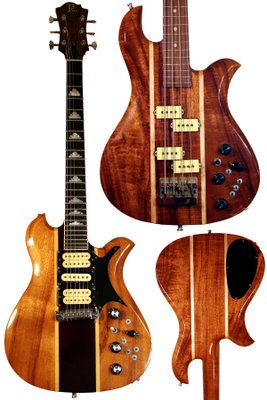
 Later, in the airport on my way home, I took it out of it's case to make sure it was surviving the trip while strapped to my back. A young Hawaiian man sitting in the next isle saw it and came over to ask if he could look at it closer and play it. I handed it to him and he seemed to really appreciate it. (an understatement) He asked where I got it and how much I paid for it. I told him about the luthier and his little shop and told him the price. The luthier was asking $180, but I had negotiated the price down to $140 including the case. He was almost speechless. He seemed to think I got an excellent deal. (again - an understatement). I think he wanted to cancel his flight, leave the airport and go straight to that flea market and get one just like it, and then rebook his flight for another day.
Later, in the airport on my way home, I took it out of it's case to make sure it was surviving the trip while strapped to my back. A young Hawaiian man sitting in the next isle saw it and came over to ask if he could look at it closer and play it. I handed it to him and he seemed to really appreciate it. (an understatement) He asked where I got it and how much I paid for it. I told him about the luthier and his little shop and told him the price. The luthier was asking $180, but I had negotiated the price down to $140 including the case. He was almost speechless. He seemed to think I got an excellent deal. (again - an understatement). I think he wanted to cancel his flight, leave the airport and go straight to that flea market and get one just like it, and then rebook his flight for another day.




















